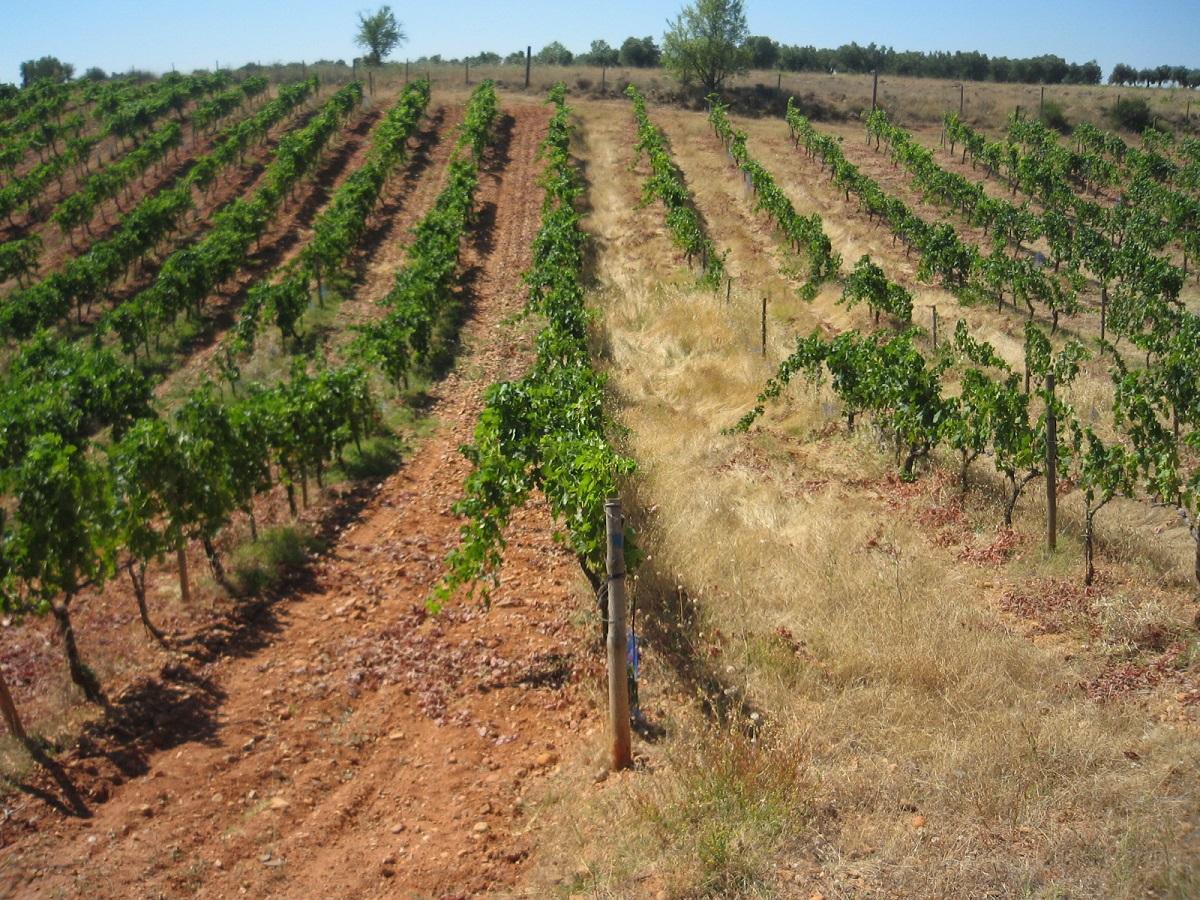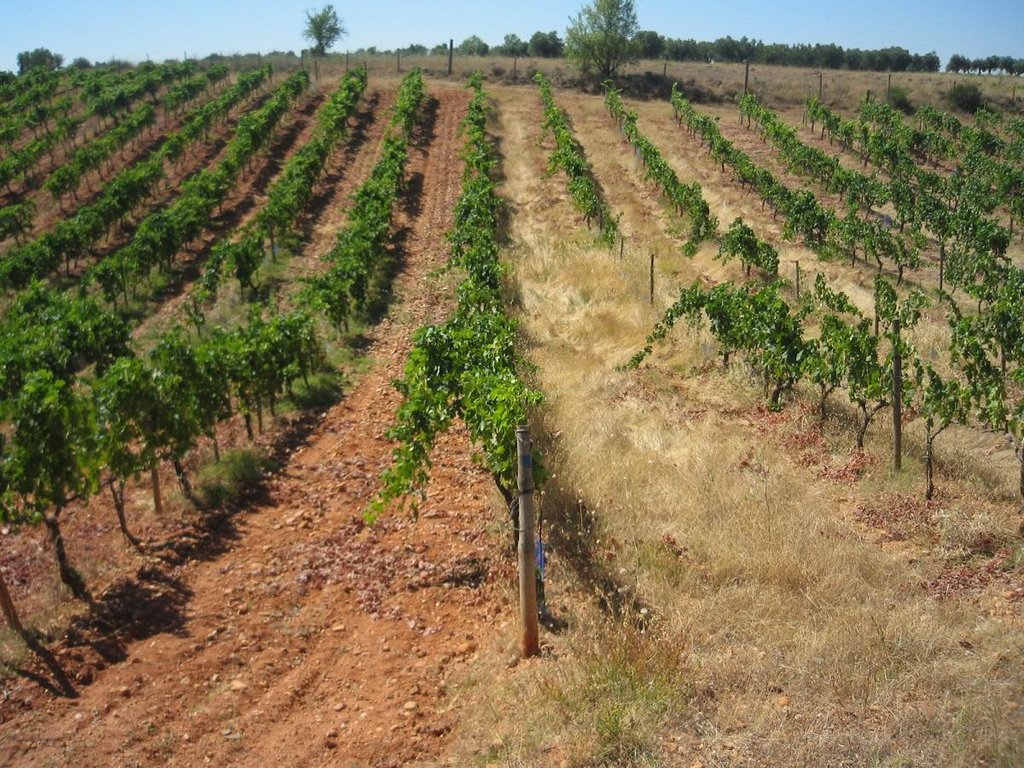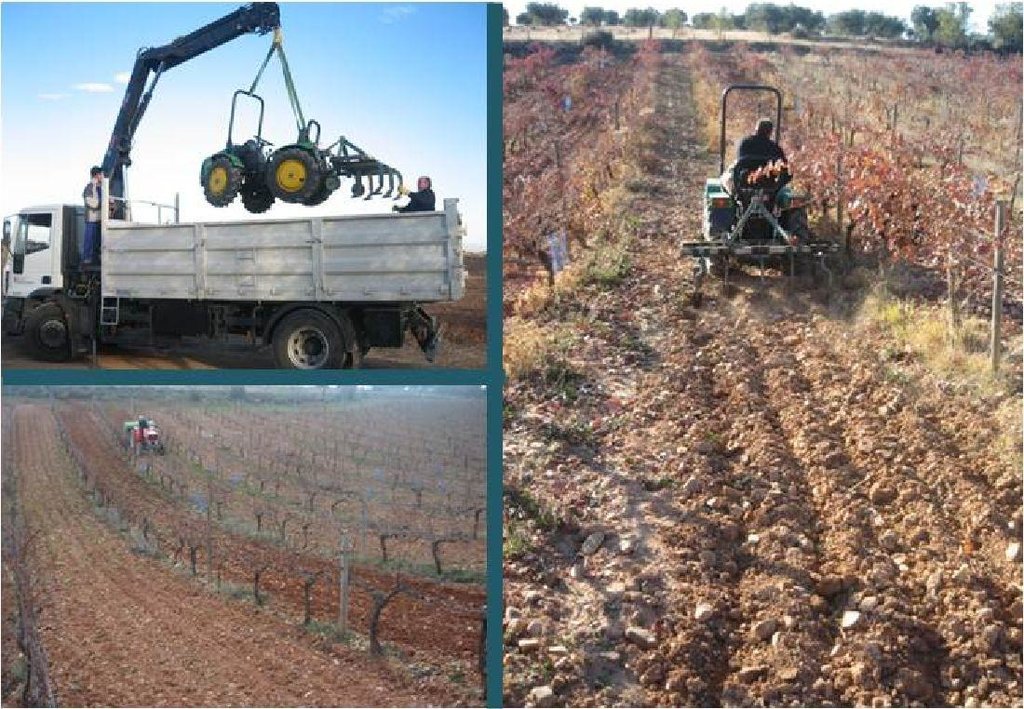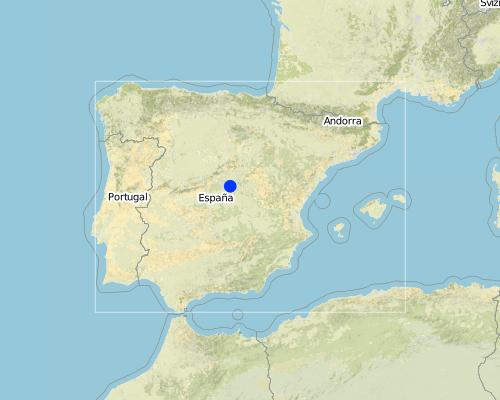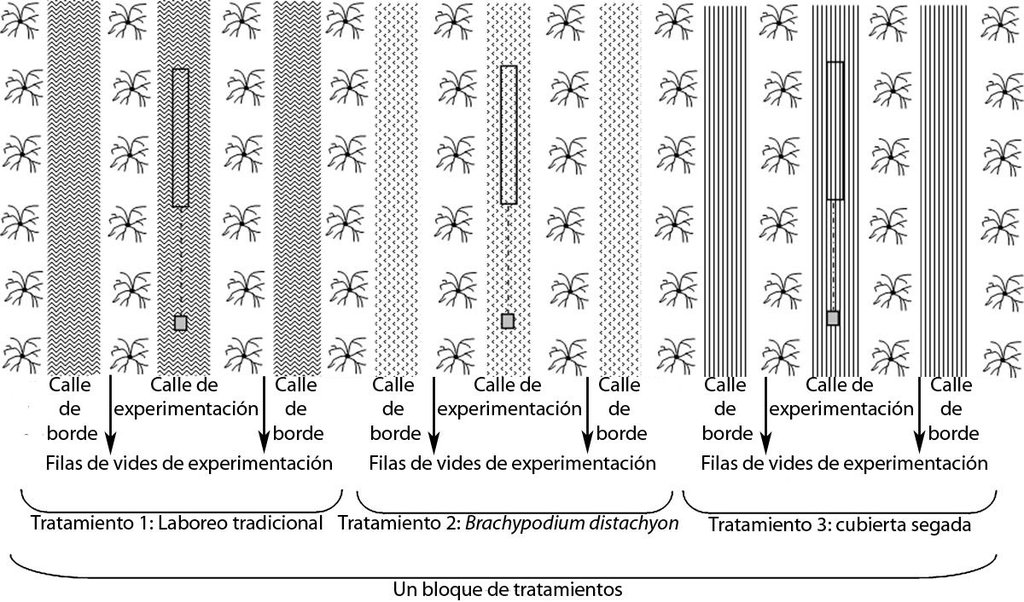Cover crops in organic vineyard [Espagne]
- Création :
- Mise à jour :
- Compilateur : CELIA BARBERO SIERRA
- Rédacteur : –
- Examinateur : Fabian Ottiger
Cubiertas vegetales en calles de viñedos
technologies_1162 - Espagne
Voir les sections
Développer tout Réduire tout1. Informations générales
1.2 Coordonnées des personnes-ressources et des institutions impliquées dans l'évaluation et la documentation de la Technologie
Spécialiste GDT:
Spécialiste GDT:
Ruíz Colmenero Marta
Instituto Madrileño de Investigación y Desarrollo Rural, Agrario y Alimentario - IMIDRA
Espagne
Spécialiste GDT:
Bienes Ramon
Instituto Madrileño de Investigación y Desarrollo Rural, Agrario y Alimentario - IMIDRA
Nom du ou des institutions qui ont facilité la documentation/ l'évaluation de la Technologie (si pertinent)
UNIVERSIDAD AUTONOMA DE MADRID (UNIVERSIDAD AUTONOMA DE MADRID) - EspagneNom du ou des institutions qui ont facilité la documentation/ l'évaluation de la Technologie (si pertinent)
IMIDRA (IMIDRA) - Espagne1.3 Conditions relatives à l'utilisation par WOCAT des données documentées
Quand les données ont-elles été compilées (sur le terrain)?
12/09/2008
Le compilateur et la(les) personne(s) ressource(s) acceptent les conditions relatives à l'utilisation par WOCAT des données documentées:
Oui
2. Description de la Technologie de GDT
2.1 Courte description de la Technologie
Définition de la Technologie:
Use of cover crops to prevent erosion and increase soil organic matter.
2.2 Description détaillée de la Technologie
Description:
In total there were 66 rows of vineyards of the Tempranillo red variety, spaced 3 m apart with a distance of 2.5 m between vines. To date they have been worked using conventional tilling without herbicides: most of the work is done mainly in the winter, followed by two or three sessions in spring aimed at controlling the growth of weeds, which is conditioned by the spring rains.
The technology is based on minimum tillage and the use of Secale cereale L and Brachypodium distachyon (L.) as cover crops to protect the soil against erosion and to increase the organic matter.
Purpose of the Technology: The main purposes of this technology are to fight against erosion and water runoff and to increase soil organic matter.
Indirectly this technology contributes to increase biodiversity in the vineyards and it could have some positive effects on wine quality (related to the content of sugar and poliphenoles) as proved by some authors (Dry et al., 2001).
Cover crops usually increase the soil moisture but on the other hand, along the summer, the cover crops and the vines are in competition for the scarce water available in the area.
Establishment / maintenance activities and inputs: The plant cover in the centre of the rows was sown in mid-November, following the copious rains in the autumn of 2006. A minimum tillage (15cm depth) is carried out before sowing. The seeding rates were 70 kg/ha for rye, Secale cereale L., and 40 kg/ha for purple false brome, Brachypodium distachyon (L.) P. Beauv. This latter cover had to be reseeded by hand since the seeds have to be buried at a very low depth. It sprouts in late winter or early spring and by late June it is already mature and dry, at which point it self-sows and it sprouts spontaneously again the following autumn. The Secale cover has to be cut in spring and re-sown in late autumn.
Once sown, the resulting vineyard was divided into alternating rows with three treatments: bare soil with traditional tilling, rows covered with Secale and rows covered with Brachypodium.
The maintenance activities consist of no tillage in winter and conservation of natural cover crops until spring.
Natural / human environment: The area is at an altitude of 800 m, in a semiarid Mediterranean climate where the recorded annual rainfall is below 400 mm and the average annual temperature is 14 ºC, with very hot and occasionally stormy summers and very cold winters. It rains primarily in spring and autumn.
The farmland is predominantly dry, especially where olives and vines are planted. Oaks (holm, Portuguese and hermes) can be found in nearby wild areas and in abandoned terrains. The study focused on the area of Campo Real in the southeast of Madrid, in the centre of Spain. The vineyard covers an area of some 2 ha of rolling hills and is located on top of limestone marl.
The farmer is the owner of the land where the technology was implemented as well as he owns other plots. The land user is one of the few organic producers in the region.
2.3 Photos de la Technologie
2.5 Pays/ région/ lieux où la Technologie a été appliquée et qui sont couverts par cette évaluation
Pays:
Espagne
Région/ Etat/ Province:
Madrid, Spain
Autres spécifications du lieu:
Campo Real
Map
×2.6 Date de mise en œuvre de la Technologie
Si l'année précise est inconnue, indiquez la date approximative: :
- il y a moins de 10 ans (récemment)
2.7 Introduction de la Technologie
Spécifiez comment la Technologie a été introduite: :
- au cours d'expérimentations / de recherches
- par le biais de projets/ d'interventions extérieures
Commentaires (type de projet, etc.) :
Projects FP 06-DR3-VID IMIDRA and RTA2007-86 INIA, Bodegas y Viñedos Gosálbez-Ortí.
3. Classification de la Technologie de GDT
3.2 Type(s) actuel(s) d'utilisation des terres, là où la Technologie est appliquée

Terres cultivées
- Plantations d’arbres ou de buissons
Principales cultures (vivrières et commerciales):
Major cash crop: Wine
Commentaires:
Major land use problems (compiler’s opinion): Erosion and low soil organic matter content.
Major land use problems (land users’ perception): Water scarcity, climatic extreme events, low agricultural income.
3.3 Informations complémentaires sur l'utilisation des terres
Approvisionnement en eau des terres sur lesquelles est appliquée la Technologie:
- pluvial
Nombre de période de croissance par an: :
- 1
Précisez:
Longest growing period in days: 75Longest growing period from month to month: February-April (Secale cereale)Second longest growing period in days: 90Second longest growing period from month to month: February-June (B distachyon)
3.4 Groupe de GDT auquel appartient la Technologie
- Amélioration de la couverture végétale/ du sol
3.5 Diffusion de la Technologie
Commentaires:
Total area covered by the SLM Technology is 0.02 m2.
3.6 Mesures de GDT constituant la Technologie

pratiques agronomiques
- A1: Couverture végétale/ du sol
- A2: Matière organique/ fertilité du sol
Commentaires:
Main measures: agronomic measures
Type of agronomic measures: better crop cover, contour planting / strip cropping, cover cropping, mulching, manure / compost / residues, breaking crust / sealed surface, minimum tillage
3.7 Principaux types de dégradation des terres traités par la Technologie

érosion hydrique des sols
- Wt: perte de la couche superficielle des sols (couche arable)/ érosion de surface

dégradation chimique des sols
- Cn: baisse de la fertilité des sols et réduction du niveau de matière organique (non causée par l’érosion)

dégradation physique des sols
- Pc: compaction
- Pk: scellage et encroûtement

dégradation biologique
- Bl: perte de la vie des sols
Commentaires:
Main type of degradation addressed: Wt: loss of topsoil / surface erosion
Secondary types of degradation addressed: Cn: fertility decline and reduced organic matter content, Pc: compaction, Pk: sealing and crusting, Bl: loss of soil life
Main causes of degradation: soil management (Bare soil by traditional tillage in sloping lands), deforestation / removal of natural vegetation (incl. forest fires) (Lack of vegetation increases soil erodibility), disturbance of water cycle (infiltration / runoff) (Increase the annual rate of rain infiltration due to high vegetation cover), Heavy / extreme rainfall (intensity/amounts) (Extreme events- storms), droughts
Secondary causes of degradation: other natural causes (avalanches, volcanic eruptions, mud flows, highly susceptible natural resources, extreme topography, etc.) specify (Slope between 10 to 15%), land tenure (Uncertainties on future land tenure implies overexploitation of land in the short run)
3.8 Prévention, réduction de la dégradation ou réhabilitation des terres dégradées
Spécifiez l'objectif de la Technologie au regard de la dégradation des terres:
- prévenir la dégradation des terres
- réduire la dégradation des terres
Commentaires:
Main goals: prevention of land degradation
Secondary goals: mitigation / reduction of land degradation
4. Spécifications techniques, activités, intrants et coûts de mise en œuvre
4.1 Dessin technique de la Technologie
4.2 Spécification/ explications techniques du dessin technique
Cover crops are sown in the middle of the strips of the lines of vineyard.(Bare soil under the vines: 50 cm wide; cropped strips: 2 m wide)
Location: Campo Real. Madrid, Spain
Date: 2008
Technical knowledge required for field staff / advisors: moderate (Selection of cover crops and management.
Botanical and agronomic knowledge required.)
Technical knowledge required for land users: moderate (Use of appropriate machinery.)
Main technical functions: control of raindrop splash, control of dispersed runoff: retain / trap, control of dispersed runoff: impede / retard, improvement of ground cover, increase of surface roughness, improvement of surface structure (crusting, sealing), improvement of topsoil structure (compaction), stabilisation of soil (eg by tree roots against land slides), increase in organic matter, increase of infiltration, sediment retention / trapping, sediment harvesting, increase of biomass (quantity), promotion of vegetation species and varieties (quality, eg palatable fodder)
Secondary technical functions: increase in nutrient availability (supply, recycling,…), increase / maintain water stored in soil, increase of groundwater level / recharge of groundwater
Better crop cover
Material/ species: Secale cereale
Quantity/ density: 70 kg/ha
Remarks: decrease soil erosion and it does not compete for water.
Contour planting / strip cropping
Material/ species: Vineyard plus cereals
Remarks: bare soil under the vines: 50 cm wide; cropped strips: 2 m wide
Cover cropping
Material/ species: Brachypodium distachyon
Quantity/ density: 40 kg/ha
Remarks: best coverage and SOM increase, but reduces the grape production too much due to water competition
Mulching
Material/ species: Straw of Secale cereale
Remarks: Conservation of cut rye on site
Manure / compost / residues
Material/ species: Secale cereale and Brachypodium distachyon
Remarks: roots and residues (straw) left in soil increase SOM
Breaking crust / sealed surface
Remarks: cover crops avoid soil crusting
Minimum tillage
Material/ species: up to 15 cm soil depth
Quantity/ density: 15 cm
Remarks: before sowing
Vegetative measure: in the middle of the lines of vines
Vegetative material: G : grass
Vegetative measure: Vegetative material: G : grass
Vegetative measure: Vegetative material: G : grass
Vegetative measure: Vegetative material: G : grass
Fruit trees / shrubs species: Grapes (50cm) /grass see G (cover crops) (2m)
Grass species: rye (Secale cereale) and bromus (Brachypodium distachyon) (2m)
4.3 Informations générales sur le calcul des intrants et des coûts
autre/ monnaie nationale (précisez):
euro
Indiquer le taux de change du dollars en monnaie locale (si pertinent): 1 USD= :
1,34
Indiquez le coût salarial moyen de la main d'œuvre par jour:
46.90
4.4 Activités de mise en place/ d'établissement
| Activité | Type de mesures | Calendrier | |
|---|---|---|---|
| 1. | Buy secale cereale seed, 70 kg per ha | Agronomique | |
| 2. | Buy B. distachyon seed, 40 kg per ha | Agronomique |
4.5 Coûts et intrants nécessaires à la mise en place
| Spécifiez les intrants | Unité | Quantité | Coûts par unité | Coût total par intrant | % des coût supporté par les exploitants des terres | |
|---|---|---|---|---|---|---|
| Main d'œuvre | Labour | ha | 1,0 | 140,7 | 140,7 | 100,0 |
| Equipements | Machine use | ha | 1,0 | 51,46 | 51,46 | 100,0 |
| Matériel végétal | Seeds | ha | 1,0 | 354,43 | 354,43 | |
| Coût total de mise en place de la Technologie | 546,59 | |||||
Commentaires:
Duration of establishment phase: 6 month(s)
Life span of the product: B. distachyon seed, 4-5 years
Life span of the product: Secale cereale seed, 1 year
4.6 Activités d'entretien/ récurrentes
| Activité | Type de mesures | Calendrier/ fréquence | |
|---|---|---|---|
| 1. | Minimum tillage and seeding in one go (Secale cereale) | Agronomique | Annually in late autumn or winter |
| 2. | Seeding (B distachyon) | Agronomique | Every 5 years |
| 3. | Mowing Secale cereale 1 ha | Agronomique | Once a year |
4.7 Coûts et intrants nécessaires aux activités d'entretien/ récurrentes (par an)
| Spécifiez les intrants | Unité | Quantité | Coûts par unité | Coût total par intrant | % des coût supporté par les exploitants des terres | |
|---|---|---|---|---|---|---|
| Main d'œuvre | Labour | ha | 1,0 | 140,7 | 140,7 | 100,0 |
| Equipements | Machine use | ha | 1,0 | 51,46 | 51,46 | 100,0 |
| Matériel végétal | Seeds | ha | 1,0 | 113,23 | 113,23 | |
| Coût total d'entretien de la Technologie | 305,39 | |||||
Commentaires:
Machinery/ tools: tractor, brushcutter
Grass strips per hectare in 2008.
4.8 Facteurs les plus importants affectant les coûts
Décrivez les facteurs les plus importants affectant les coûts :
Labour and price of B. distachyon seeds as it is not a commercial seed.
5. Environnement naturel et humain
5.1 Climat
Précipitations annuelles
- < 250 mm
- 251-500 mm
- 501-750 mm
- 751-1000 mm
- 1001-1500 mm
- 1501-2000 mm
- 2001-3000 mm
- 3001-4000 mm
- > 4000 mm
Spécifiez la pluviométrie moyenne annuelle (si connue), en mm:
400,00
Spécifications/ commentaires sur les précipitations:
Autumn and spring
Zone agro-climatique
- semi-aride
Thermal climate class: temperate
5.2 Topographie
Pentes moyennes:
- plat (0-2 %)
- faible (3-5%)
- modéré (6-10%)
- onduleux (11-15%)
- vallonné (16-30%)
- raide (31-60%)
- très raide (>60%)
Reliefs:
- plateaux/ plaines
- crêtes
- flancs/ pentes de montagne
- flancs/ pentes de colline
- piémonts/ glacis (bas de pente)
- fonds de vallée/bas-fonds
Zones altitudinales:
- 0-100 m
- 101-500 m
- 501-1000 m
- 1001-1500 m
- 1501-2000 m
- 2001-2500 m
- 2501-3000 m
- 3001-4000 m
- > 4000 m
Indiquez si la Technologie est spécifiquement appliquée dans des:
- situations concaves
Commentaires et précisions supplémentaires sur la topographie:
Slopes on average: Rolling (10-14%)
5.3 Sols
Profondeur moyenne du sol:
- très superficiel (0-20 cm)
- superficiel (21-50 cm)
- modérément profond (51-80 cm)
- profond (81-120 cm)
- très profond (>120 cm)
Texture du sol (de la couche arable):
- moyen (limoneux)
Matière organique de la couche arable:
- moyen (1-3%)
Si disponible, joignez une description complète du sol ou précisez les informations disponibles, par ex., type de sol, pH/ acidité du sol, capacité d'échange cationique, azote, salinité, etc.
Soil texture is medium (sandy loam)
Soil fertility is medium
Topsoil organic matter is medium (1.3%)
Soil drainage/infiltration is medium
Soil water storage capacity is medium
5.4 Disponibilité et qualité de l'eau
Disponibilité de l’eau de surface:
moyenne
Qualité de l’eau (non traitée):
faiblement potable (traitement nécessaire)
Commentaires et précisions supplémentaires sur la qualité et la quantité d'eau:
Ground water table: No data avalilable
Availability of surface of water: During the maximum water requirements of vines (June-July) water is not available usually.
5.5 Biodiversité
Diversité des espèces:
- faible
5.6 Caractéristiques des exploitants des terres appliquant la Technologie
Orientation du système de production:
- commercial/ de marché
Niveau relatif de richesse:
- moyen
Individus ou groupes:
- individu/ ménage
Niveau de mécanisation:
- mécanisé/ motorisé
Genre:
- hommes
Indiquez toute autre caractéristique pertinente des exploitants des terres:
Land users applying the Technology are mainly Leaders / privileged
Difference in the involvement of women and men: Traditionally vineyard sector in Spain is driven by men.
Population density: 10-50 persons/km2
Annual population growth: negative
Off-farm income specification: This information is not available.
Market orientation is commercial/market (wine).
5.7 Superficie moyenne des terres détenues ou louées par les exploitants appliquant la Technologie
- < 0,5 ha
- 0,5-1 ha
- 1-2 ha
- 2-5 ha
- 5-15 ha
- 15-50 ha
- 50-100 ha
- 100-500 ha
- 500-1 000 ha
- 1 000-10 000 ha
- > 10 000 ha
Cette superficie est-elle considérée comme de petite, moyenne ou grande dimension (en se référant au contexte local)?
- petite dimension
5.8 Propriété foncière, droits d’utilisation des terres et de l'eau
Propriété foncière:
- individu, avec titre de propriété
Droits d’utilisation des terres:
- individuel
Droits d’utilisation de l’eau:
- individuel
5.9 Accès aux services et aux infrastructures
santé:
- pauvre
- modéré
- bonne
éducation:
- pauvre
- modéré
- bonne
assistance technique:
- pauvre
- modéré
- bonne
emploi (par ex. hors exploitation):
- pauvre
- modéré
- bonne
marchés:
- pauvre
- modéré
- bonne
énergie:
- pauvre
- modéré
- bonne
routes et transports:
- pauvre
- modéré
- bonne
eau potable et assainissement:
- pauvre
- modéré
- bonne
services financiers:
- pauvre
- modéré
- bonne
6. Impacts et conclusions
6.1 Impacts sur site que la Technologie a montrés
Impacts socio-économiques
Production
production agricole
Commentaires/ spécifiez:
Depending on the cover crop (B. distachyon)
production fourragère
Commentaires/ spécifiez:
But not really used
Disponibilité et qualité de l'eau
disponibilité de l'eau d'irrigation
qualité de l'eau d'irrigation
demande pour l'eau d'irrigation
Revenus et coûts
revenus agricoles
Commentaires/ spécifiez:
Related to the quality and price of wine
charge de travail
Commentaires/ spécifiez:
No tillage
Impacts socioculturels
connaissances sur la GDT/ dégradation des terres
Landusers perception of the landscape
Commentaires/ spécifiez:
The farmers use to prefer the landscape of their vineyards with "clean" soil. They consider cover crops as weeds.
Improved livelihoods and human well-being
Commentaires/ spécifiez:
This SLM Technology contributes to soil improvement but has no direct impacts on human wellbeing of the land users. Due to organic labelling of the product, the price of wine may increase wich also increases farm income.
Impacts écologiques
Cycle de l'eau/ ruissellement
ruissellement de surface
Commentaires/ spécifiez:
More than 80% of runoff reduction in B. distachyon and more than 60% for Secale.
évaporation
Sols
humidité du sol
Commentaires/ spécifiez:
Depending on the cover. B. distachyon increases soil moisture in autumn and winter. From May to July soil moisture heavely decreased, the rest of the year the cover crops increase soil moisture compared with bare soil
couverture du sol
perte en sol
Commentaires/ spécifiez:
93% in permanent cover crops
encroûtement/ battance du sol
compaction du sol
Commentaires/ spécifiez:
Due to less use of heavy machinery
matière organique du sol/ au dessous du sol C
Quantité avant la GDT:
1.27%
Quantité après la GDT:
1.6%
Commentaires/ spécifiez:
From 1.27% to 1.6% in three years for permanent covers
6.2 Impacts hors site que la Technologie a montrés
disponibilité de l'eau
inondations en aval
pollution des rivières/ nappes phréatiques
capacité tampon/de filtration
sédiments (indésirables) transportés par le vent
dommages sur les champs voisins
dommages sur les infrastructures publiques/ privées
6.3 Exposition et sensibilité de la Technologie aux changements progressifs et aux évènements extrêmes/catastrophes liés au climat (telles que perçues par les exploitants des terres)
Changements climatiques progressifs
Changements climatiques progressifs
| Saison | Type de changements/ extrêmes climatiques | Comment la Technologie fait-elle face à cela? | |
|---|---|---|---|
| températures annuelles | augmente | bien |
Extrêmes climatiques (catastrophes)
Catastrophes météorologiques
| Comment la Technologie fait-elle face à cela? | |
|---|---|
| pluie torrentielle locale | bien |
| tempête de vent locale | pas connu |
Catastrophes climatiques
| Comment la Technologie fait-elle face à cela? | |
|---|---|
| sécheresse | bien |
Catastrophes hydrologiques
| Comment la Technologie fait-elle face à cela? | |
|---|---|
| inondation générale (rivière) | pas bien |
Autres conséquences liées au climat
Autres conséquences liées au climat
| Comment la Technologie fait-elle face à cela? | |
|---|---|
| réduction de la période de croissance | bien |
Commentaires:
The species were chosen to be tolerant to drought and poor soil conditions
6.4 Analyse coûts-bénéfices
Quels sont les bénéfices comparativement aux coûts de mise en place (du point de vue des exploitants des terres)?
Rentabilité à court terme:
neutre / équilibrée
Rentabilité à long terme:
légèrement positive
Quels sont les bénéfices comparativement aux coûts d'entretien récurrents (du point de vue des exploitants des terres)?
Rentabilité à court terme:
neutre / équilibrée
Rentabilité à long terme:
légèrement positive
Commentaires:
This particular land user is an organic farmer and he is willing to change his manangament practices but tradtional farmers in the region have a very negative vision of this kind of SLM techs.
6.5 Adoption de la Technologie
Si disponible, quantifiez (nombre de ménages et/ou superficie couverte):
1
Commentaires:
100% of land user families have adopted the Technology with external material support
1 land user families have adopted the Technology with external material support
There is no trend towards spontaneous adoption of the Technology
6.7 Points forts/ avantages/ possibilités de la Technologie
| Points forts/ avantages/ possibilités du point de vue de l'exploitant des terres |
|---|
|
Increase in wine quality How can they be sustained / enhanced? Maintaining this SLM practice along the time |
|
Prevention of erosion How can they be sustained / enhanced? Maintaining this SLM practice along the time |
|
Decrease in intensity and frequency of tillage How can they be sustained / enhanced? Maintaining this SLM practice along the time |
| Points forts/ avantages/ possibilités du point de vue du compilateur ou d'une autre personne ressource clé |
|---|
|
Increase of soil organic matter How can they be sustained / enhanced? Maintaining this SLM practice along the time |
|
Prevention of runoff and soil erosion (change of bare (tilled) soil by cover crops) How can they be sustained / enhanced? Maintaining this SLM practice along the time |
|
Increase in biodiversity How can they be sustained / enhanced? Maintaining this SLM practice along the time |
|
Increase in wine quality (related to the content of sugar and polyphenols), as proved by some authors (Dry et al., 2001) How can they be sustained / enhanced? Maintaining this SLM practice along the time |
|
The costs are reduced through reduced use of tractor (decreased intensity of tillage) How can they be sustained / enhanced? Maintaining this SLM practice along the time |
6.8 Faiblesses/ inconvénients/ risques de la Technologie et moyens de les surmonter
| Faiblesses/ inconvénients/ risques du point de vue de l’exploitant des terres | Comment peuvent-ils être surmontés? |
|---|---|
| Lack of knowledge or training to adopt this technologies | Awareness raising campaigns |
| Faiblesses/ inconvénients/ risques du point de vue du compilateur ou d'une autre personne ressource clé | Comment peuvent-ils être surmontés? |
|---|---|
| Soil moisture decreases during certain months | Mowing the cover in spring |
| High costs of the most effective seed (8.04$/kg) (B. distachyon) | Using other similar and cheaper seeds |
7. Références et liens
7.2 Références des publications disponibles
Titre, auteur, année, ISBN:
M.J. Marques , S. García-Muñoz , G. Muñoz-Organero , R. Bienes. 2009. Soil conservation beneath grass cover in hillside vineyards under mediterranean climatic conditions. Land Degradation and Development. 21: 122-131.
Ruiz-Colmenero, S; Bienes R.; Marques MJ. 2011. Soil and water conservation dilemmas associated with the use of green cover in steep vineyards. Soil & Tillage Research 117, 211-223.
Bienes R., Marques MJ, Ruiz Colmenero M 2012. Cereales, viñedos y olivares. El manejo tradicional del suelo y sus consecuencias en la erosión hídrica. La erosión y la hidrología en campos de cultivo en España. Cuadernos de Investigación Geográfica 38(1), 49-74.
Ruiz-Colmenero, M., Bienes, R., Eldridge, D.J. and Marqués, M.J. 2013. Vegetation cover reduces erosion and enhances soil organic carbon in a vineyard in the central Spain. Catena. 104, 153-160.
Liens et modules
Développer tout Réduire toutLiens
Aucun lien
Modules
Aucun module trouvé


